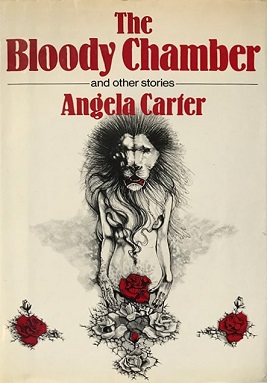

英語文化コミュニケーション学科
英文学科教員リレーエッセイ
この新着情報のコーナーで、英文学科教員による短いエッセーを随時掲載しています。今回は、文学がご専門のMarianne Kimura先生にアンジェラ・カーター(イギリス人小説家)と「せつない」という概念について書いていただきました。以下、Kimura先生の文章ですが、原文の英語につづき、日本語訳もそえています。
●Setsunai Snow and Moon in Angela Carter’s Stories
Angela Carter (1940–1992) is one of my favorite writers and one of the major post-war writers in Britain. Her most famous work is the short story “The Company of Wolves”, which is an adaptation of “Little Red Riding Hood”. In “The Company of Wolves”, the wolf is a supernatural half-wolf/half-man character instead of a real wolf, and Little Red Riding Hood is a young woman instead of a child. In Carter’s hands, the story becomes a romance for adults.
Her beautiful story “The Courtship of Mr. Lyon” is an adaptation of “Beauty and the Beast”, but she sets her version in the modern era. So, for example, Beauty’s father has a car which gets stuck in a snowdrift in front of the Beast’s beautiful house and that’s how he meets the Beast.
Both of these stories emphasize snow in the scenery and also, the moon plays an important role in setting a tone of haunting natural loveliness. Every time I read Carter’s moody lines describing the scenery, such as “It was a white night of moon and snow” or the snowy “road is white and unmarked as a bolt of bridal satin”, I can’t help but wonder if Carter was influenced by her stay in Japan, for about two years, beginning in 1969.
I read that Carter studied the Japanese concept of “setsunai” and, while taking a walk with her Japanese friends, she would ask them if they thought a flower growing alone at the side of the road was “setsunai” or not. I think that Carter may have been deeply touched by the concept of “setsunai” which means “lonely” or “sad”. Snow and the moon are images often portrayed in haiku and Japanese song lyrics to create a mood of loneliness and haunting, ethereal beauty. On the other hand, western stories and songs often portray snow as jolly and festive, while the moon is associated with Halloween, witches, magic, illusions, “lunacy” (which comes from the word lunar, meaning moon) and with spooky supernatural creatures like fairies, for example, in Shakespeare’s “A Midsummer Night’s Dream”.
Carter’s depictions of the moon and snow as rather like a part of nature are more in line with the Japanese concept of “setsunai”. In “The Company of Wolves”, under the bright moon, thin wolves howl in a garden covered in snow, while inside the house, the half-man and half-wolf explains: “Those are the voices of my brothers”, to the young woman. Yet, although they are his brothers, there is a separation. The snow and the moon symbolize the wild and natural world, which tugs at our heartstrings with its beauty, but remains always a little elusive.
●(日本語訳)「アンジェラ・カーター作品における<せつない>雪と月」
アンジェラ・カーター(1940—1992)は私の大好きな作家なのですが、戦後の英国を代表する作家のひとりといえます。カーターの最も有名な作品は「狼たちの仲間」という短編ですが、これは「赤ずきんちゃん」の翻案です。この作品では、狼は本当の狼ではなく、自然界には存在しない半人半獣のキャラクターで、赤ずきんちゃんは子供ではなく、若い女性です。カーターの手により、お話が大人のための物語に変容しました。
「野獣の求婚」というとても美しい短編では、カーターは「美女と野獣」を翻案していて、時代設定は現代となっています。このため、たとえば美女の父親は車を運転しますが、車は吹き溜まりとなった雪のため、野獣の壮麗な邸宅の前で立ち往生し、父親と野獣が出会うことになります。
どちらの作品においても、その情景には雪の存在が強調され、また月が重要な役割を果たし、印象深い自然の美を提示しています。「月と雪の白い夜のできごとでした」あるいは「その道は(雪で)白く輝き、花嫁衣裳のサテン生地のようになめらかである」——このような情感をたたえたカーターのペンに出会うたびに、私はいつも考えさせられます。カーターはもしかして日本での滞在に影響を受けたのではないだろうか、と。カーターは1969年からの2年間、日本に滞在しています。
カーターは「せつない」という日本語の概念について学んだことがある、と私はどこかで読んだことがあります。カーターは、日本の友人と散歩をしているとき、道端にポツンと花が一輪咲いているのを見て、それは「せつない」のかどうか、よく尋ねたということです。「さびしい」「悲しい」のような意味をもつ「せつない」という概念にカーターは深く感じ入ったのだろうと思います。雪と月は、日本では俳句や歌詞において、さびしさやこの世のものとは思えないほどの美を伝えるためにしばしば用いられます。一方、西洋の物語や歌詞では、雪といえば楽しくワクワクしたイメージをもつもので、月といえばハロウィン、魔女、魔法、幻、「狂気」が連想されます。(英単語の「狂気 (=lunacy)」は「月の…」を意味するlunarに由来します。)さらに、月といえば、たとえばシェイクスピアの『夏の夜の夢』に出てくる妖精のような自然界には存在しないものも連想されます。
カーターは雪と月を自然の一部として描写していますが、これは「せつない」という日本語の概念に関連がありそうです。短編「狼の仲間」では、月に照らされ、雪に覆われた庭で、餓狼が吠えます。一方、家の中では半人半獣のキャラクターが女性に「これは私の兄弟たちの声だ」といいます。餓狼と半人半獣のキャラクターは兄弟ですが、その間には隔絶があります。月と雪が人の手のつかない自然の世界を象徴しており、その美に心が引かれますが、それはいつも捉えることが難しいものです。
●つけたし
アンジェラ・カーターの短編「狼たちの仲間」と「野獣の求婚」は翻訳書の『血染めの部屋』(アンジェラ・カーター 著、富士川義之 訳、筑摩書房)で読むことができます。
サムネイルの写真はMarianne Kimura先生で、本文記事の下の写真は『血染めの部屋』の原書The Bloody Chamberの書影です。
●Setsunai Snow and Moon in Angela Carter’s Stories
Angela Carter (1940–1992) is one of my favorite writers and one of the major post-war writers in Britain. Her most famous work is the short story “The Company of Wolves”, which is an adaptation of “Little Red Riding Hood”. In “The Company of Wolves”, the wolf is a supernatural half-wolf/half-man character instead of a real wolf, and Little Red Riding Hood is a young woman instead of a child. In Carter’s hands, the story becomes a romance for adults.
Her beautiful story “The Courtship of Mr. Lyon” is an adaptation of “Beauty and the Beast”, but she sets her version in the modern era. So, for example, Beauty’s father has a car which gets stuck in a snowdrift in front of the Beast’s beautiful house and that’s how he meets the Beast.
Both of these stories emphasize snow in the scenery and also, the moon plays an important role in setting a tone of haunting natural loveliness. Every time I read Carter’s moody lines describing the scenery, such as “It was a white night of moon and snow” or the snowy “road is white and unmarked as a bolt of bridal satin”, I can’t help but wonder if Carter was influenced by her stay in Japan, for about two years, beginning in 1969.
I read that Carter studied the Japanese concept of “setsunai” and, while taking a walk with her Japanese friends, she would ask them if they thought a flower growing alone at the side of the road was “setsunai” or not. I think that Carter may have been deeply touched by the concept of “setsunai” which means “lonely” or “sad”. Snow and the moon are images often portrayed in haiku and Japanese song lyrics to create a mood of loneliness and haunting, ethereal beauty. On the other hand, western stories and songs often portray snow as jolly and festive, while the moon is associated with Halloween, witches, magic, illusions, “lunacy” (which comes from the word lunar, meaning moon) and with spooky supernatural creatures like fairies, for example, in Shakespeare’s “A Midsummer Night’s Dream”.
Carter’s depictions of the moon and snow as rather like a part of nature are more in line with the Japanese concept of “setsunai”. In “The Company of Wolves”, under the bright moon, thin wolves howl in a garden covered in snow, while inside the house, the half-man and half-wolf explains: “Those are the voices of my brothers”, to the young woman. Yet, although they are his brothers, there is a separation. The snow and the moon symbolize the wild and natural world, which tugs at our heartstrings with its beauty, but remains always a little elusive.
●(日本語訳)「アンジェラ・カーター作品における<せつない>雪と月」
アンジェラ・カーター(1940—1992)は私の大好きな作家なのですが、戦後の英国を代表する作家のひとりといえます。カーターの最も有名な作品は「狼たちの仲間」という短編ですが、これは「赤ずきんちゃん」の翻案です。この作品では、狼は本当の狼ではなく、自然界には存在しない半人半獣のキャラクターで、赤ずきんちゃんは子供ではなく、若い女性です。カーターの手により、お話が大人のための物語に変容しました。
「野獣の求婚」というとても美しい短編では、カーターは「美女と野獣」を翻案していて、時代設定は現代となっています。このため、たとえば美女の父親は車を運転しますが、車は吹き溜まりとなった雪のため、野獣の壮麗な邸宅の前で立ち往生し、父親と野獣が出会うことになります。
どちらの作品においても、その情景には雪の存在が強調され、また月が重要な役割を果たし、印象深い自然の美を提示しています。「月と雪の白い夜のできごとでした」あるいは「その道は(雪で)白く輝き、花嫁衣裳のサテン生地のようになめらかである」——このような情感をたたえたカーターのペンに出会うたびに、私はいつも考えさせられます。カーターはもしかして日本での滞在に影響を受けたのではないだろうか、と。カーターは1969年からの2年間、日本に滞在しています。
カーターは「せつない」という日本語の概念について学んだことがある、と私はどこかで読んだことがあります。カーターは、日本の友人と散歩をしているとき、道端にポツンと花が一輪咲いているのを見て、それは「せつない」のかどうか、よく尋ねたということです。「さびしい」「悲しい」のような意味をもつ「せつない」という概念にカーターは深く感じ入ったのだろうと思います。雪と月は、日本では俳句や歌詞において、さびしさやこの世のものとは思えないほどの美を伝えるためにしばしば用いられます。一方、西洋の物語や歌詞では、雪といえば楽しくワクワクしたイメージをもつもので、月といえばハロウィン、魔女、魔法、幻、「狂気」が連想されます。(英単語の「狂気 (=lunacy)」は「月の…」を意味するlunarに由来します。)さらに、月といえば、たとえばシェイクスピアの『夏の夜の夢』に出てくる妖精のような自然界には存在しないものも連想されます。
カーターは雪と月を自然の一部として描写していますが、これは「せつない」という日本語の概念に関連がありそうです。短編「狼の仲間」では、月に照らされ、雪に覆われた庭で、餓狼が吠えます。一方、家の中では半人半獣のキャラクターが女性に「これは私の兄弟たちの声だ」といいます。餓狼と半人半獣のキャラクターは兄弟ですが、その間には隔絶があります。月と雪が人の手のつかない自然の世界を象徴しており、その美に心が引かれますが、それはいつも捉えることが難しいものです。
●つけたし
アンジェラ・カーターの短編「狼たちの仲間」と「野獣の求婚」は翻訳書の『血染めの部屋』(アンジェラ・カーター 著、富士川義之 訳、筑摩書房)で読むことができます。
サムネイルの写真はMarianne Kimura先生で、本文記事の下の写真は『血染めの部屋』の原書The Bloody Chamberの書影です。


